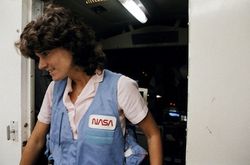From The New Yorker:
 Five months after Valentina Tereshkova became the first woman in outer space, she put on a white dress, with a puffy skirt and a veil, and married Andrian Nikolayev. The wedding was in November, 1963, in Moscow, and Nikita Khruschev was there; by some accounts, he had also pushed for marriage. Nikolayev was also a cosmonaut; to many people, it seemed romantic, and, more than that, like the logical destination for Tereshkova, a former factory worker who came to the space program by way of a parachuting club. Circle the world: land at the altar. She and Nikolayev had a daughter by the next summer, the first child on earth with two parents who’d left the planet. The marriage effectively fell apart soon afterward, although legally it lasted almost twenty years. As it happens, that was almost exactly the same interval as that between Tereshkova’s journey and that of Sally Ride, the first American woman (and third overall) in space, who died on Monday, at the age of sixty-one. Ride travelled on a space-shuttle mission in June, 1983. A few months earlier, about the same time as Tereshkova’s divorce, she, too, married a fellow astronaut, Steve Hawley, without any world leaders present. A brief story in the August 15, 1982, Times (“TWO ASTRONAUTS TELL FRIENDS OF THEIR MARRIAGE LAST MONTH”) included this line: “ ‘We didn’t want to make a big deal of it,’ Mrs. Hawley said. ‘We only told a few friends.’ ” Luckily, by the time she went into space, the Times had figured out that “Mrs. Hawley” was still Sally Ride.
Five months after Valentina Tereshkova became the first woman in outer space, she put on a white dress, with a puffy skirt and a veil, and married Andrian Nikolayev. The wedding was in November, 1963, in Moscow, and Nikita Khruschev was there; by some accounts, he had also pushed for marriage. Nikolayev was also a cosmonaut; to many people, it seemed romantic, and, more than that, like the logical destination for Tereshkova, a former factory worker who came to the space program by way of a parachuting club. Circle the world: land at the altar. She and Nikolayev had a daughter by the next summer, the first child on earth with two parents who’d left the planet. The marriage effectively fell apart soon afterward, although legally it lasted almost twenty years. As it happens, that was almost exactly the same interval as that between Tereshkova’s journey and that of Sally Ride, the first American woman (and third overall) in space, who died on Monday, at the age of sixty-one. Ride travelled on a space-shuttle mission in June, 1983. A few months earlier, about the same time as Tereshkova’s divorce, she, too, married a fellow astronaut, Steve Hawley, without any world leaders present. A brief story in the August 15, 1982, Times (“TWO ASTRONAUTS TELL FRIENDS OF THEIR MARRIAGE LAST MONTH”) included this line: “ ‘We didn’t want to make a big deal of it,’ Mrs. Hawley said. ‘We only told a few friends.’ ” Luckily, by the time she went into space, the Times had figured out that “Mrs. Hawley” was still Sally Ride.
And that is when she truly became Sally Ride—not just a scientist and athlete (she’d considered being a professional tennis player) but an icon. That meant more discussion of her personal life. A June 19, 1983, “Woman in the News” story in the Times said Ride and Hawley “were quietly married, making them the first astronauts to do so”—meaning, perhaps, the first Americans (or the first to do so quietly)—and that their house was “laced with mementos of the space age,” including “shuttle dishware.” Ride’s 1982 marriage is mentioned in her Times obituary, as is her divorce, in 1987. (The space decor comes up, too.) Then, at the end, there’s this: Dr. Ride is survived by her partner of 27 years, Tam O’Shaughnessy; her mother, Joyce; and her sister, Ms. Scott, who is known as Bear. (Dr. O’Shaughnessy is chief operating officer of Dr. Ride’s company.) Bear Scott, Ride’s sister, and her company, Sally Ride Science, confirmed to reporters that no one should mistake “partner” for business partner: “We consider Tam a member of the family,” Bear Scott told BuzzFeed. She, too, is a lesbian (and a Presbyterian minister) but more open than her sister ever was. The listing of O’Shaughnessy as Ride’s partner was apparently the first time the relationship had been in the public record. Bear Ride talked about her sister’s “very fundamental sense of privacy.”
More here.
